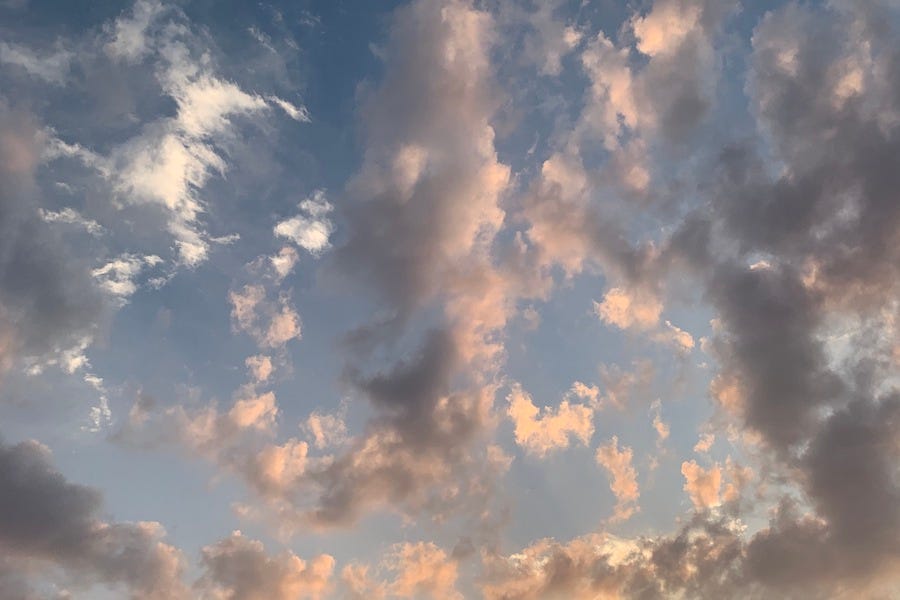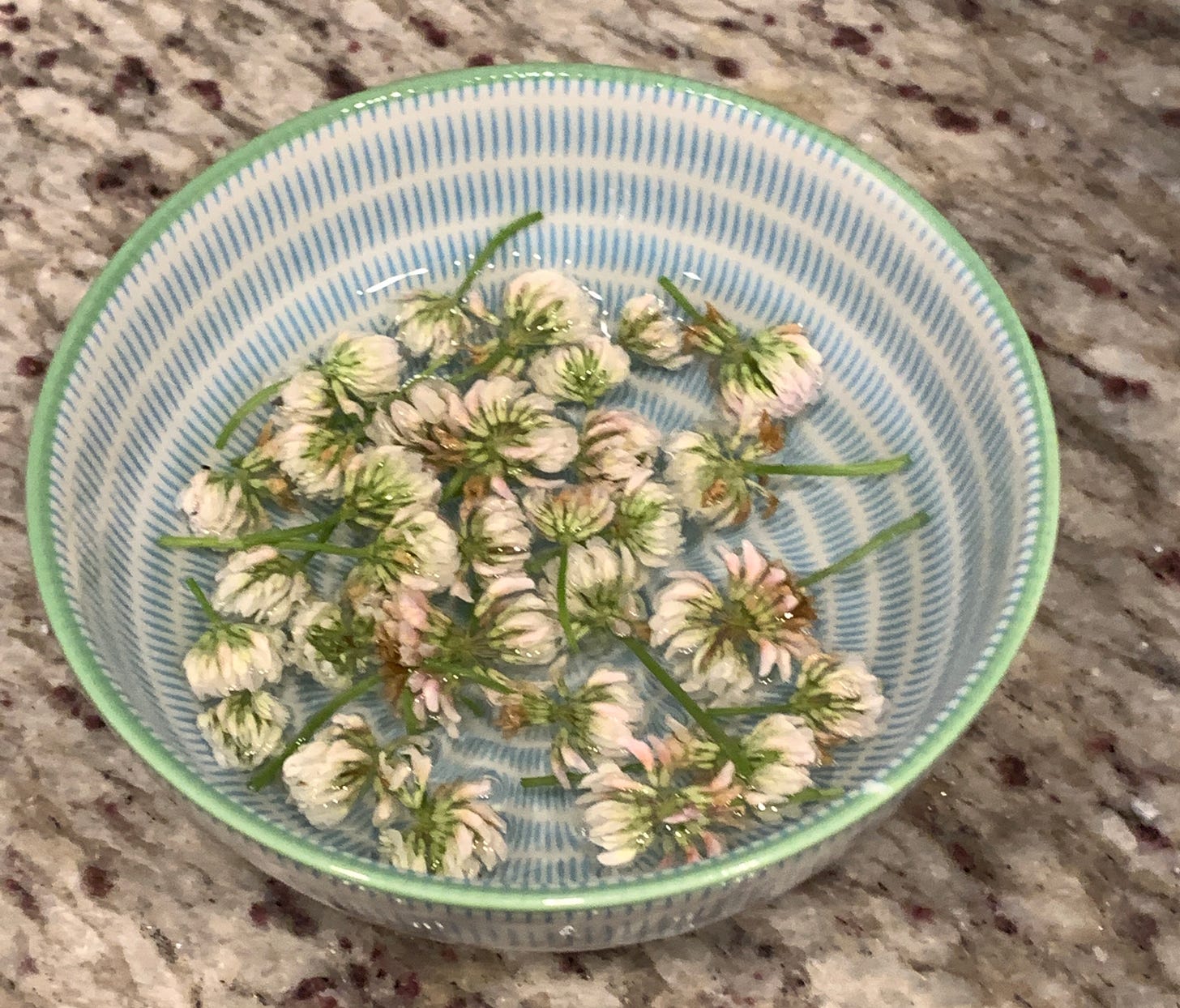One More Thing in the Sky
TOWARD SUNDOWN ON the last day of our Delaware beach vacation, we went out to try flying a kite, but when we got out onto the beach, the air was completely still. It was worth having gone anyway, because the whole sky was spattered with ludicrously beautiful clouds: big flecks of gray over flecks of silver over rose and gold; a mountain of pink cumulus in the east casting its pink reflection over the oddly smooth ocean.
When we turned back for home, in the confusion of the west, I saw something I'd never really noticed before.
At first I thought I was seeing yet another accidental juxtaposition of two different kinds of clouds at different heights: bright, sharply defined little clouds floating high up in the last sunlight, and blurry, wispy clouds below. But when I looked more carefully, they were paired off—every sharp little cloud was matched with an individual blur underneath it, like a hanging veil.
I asked Twitter what I was looking at, and user @Steve_Mang—whose bio said he is a chemistry teacher—pointed me to the United Kingdom Meteorological Office's web page about the phenomenon called “virga”: rain that falls from a cloud without making it to the ground, thanks to midair evaporation or sublimation.
Rain? On an evening that felt definitively rainless down at sea level? But the International Cloud Atlas had a photo that was a dead ringer, of virga trailing from altocumulus. Virga! This is a thing that happens in the sky.
READER ENGAGEMENT DEP’T.:
A WARM WELCOME to Indignity’s first commenter, Adam Martinez, who joined us to say: “I do not think I have a motto but it could be ‘Home is where you want to work, play, and poop.’”
APPLIED SANDWICH RECIPE DEP’T.:
INDIGNITY READER BEN sent us our second-ever comment, in response to Vol. 4's antique recipe for Rose Petal Sandwiches, asking:
Are “rose leaves” synonymous with “rose petals”? Does that hold for every other flower?
I puzzled over the same thing, when Indignity's creative director and compiler of antique recipes from public-domain cookbooks, Joe MacLeod, first showed me the recipe. Marion Harris Neil, author of the cookbook, was unfortunately unavailable for comment, since her book was published in 1916. Anatomically, petals are a modified kind of leaf, but the English language finds it helpful and useful to distinguish between the two. From the context—she did call the recipe “Rose Petal Sandwiches”—it seemed safe to guess that Neil was simply using “leaves” to mean “petals.”
What I was even more curious about, though, was Neil's concluding note: “Violets or clover blossoms may be used in place of the rose leaves.” Once again, here we have “blossoms” treated as equivalent to “leaves,” but more pressingly, how were clover blossoms supposed to be any sort of substitute for rose petals? Rose petals are famously fragrant, and rose flavor, though not especially popular in the United States, is a standard part of the cuisine of billions of people. Clover is…clover. It tastes pretty good when bees put in the work of harvesting the nectar from the tiny tubular flowers and turning it into honey, but literature is notably short on writers rhapsodizing over the rich perfume of a field of clover.
It seemed like a rather bold substitution strategy, especially in a three-ingredient recipe. Maybe Marion Harris Neil knew something I didn't, though. And since food-grade rose petals were only selling in extremely impractical quantities online, I decided to see how clover would work. Taking my younger son on a jaunt around the Pool in Central Park to tire him out, I semi-surreptitiously plucked heads of clover along the way, stooping to grab one or two of the cleanest and healthiest looking ones from each patch and then moving on to the next. I hadn't brought anything to put them in, so by the end I had a single somewhat mashed big handful of clover.
My harvest had no noticeable fragrance at all. I washed it, dislodging a single tiny insect of some sort, and then picked away the stems and the browner little outer tubules. The mechanics of the recipe—“Put a layer of rose leaves in the bottom of a jar or covered dish, put in one-half cupful of fresh, unsalted butter wrapped in wax paper, cover with a thick layer of rose leaves”—made no sense whatsoever with the entirely un-flat and un-layerable clover blossoms, so I just put some of the flowers in the bottom of a bowl, smushed some butter on top of them, and smushed the rest of the flowers into the butter from above. I used much, much less than a half-cup of butter because I was not expecting particularly flavorful or interesting results.
I put the bowl in the fridge and kept it there much longer than Neil's recommendation of “leave in a cool place over night,” partly to give the clover a better chance to impart whatever flavor it might have, partly because I forgot about it once or twice, and partly because I kept not having suitable bread around. At last, I did make it to a bakery, where I picked up an OK but entirely non-rustic demi baguette.
I got the bowl out of the fridge, let the contents soften for a while, then slathered some on a slice of the baguette, with another slice on top. It smelled like buttered bread. It tasted like buttered bread, with occasional bites of a mild grassy flavor mixed in as I chewed. When I was a bored child forced to sit on the ground at camp or in gym class, I would sometimes pluck a grass stem or some other tender looking thing and nibble on it, the way characters in old children's books were forever chewing on a blade of grass. Unless I hit the jackpot and there were some wild onions at hand, the results were at best edible and mildly distracting. The clover-blossom sandwich took me back to that: better than nothing, but not better than much of anything else.












